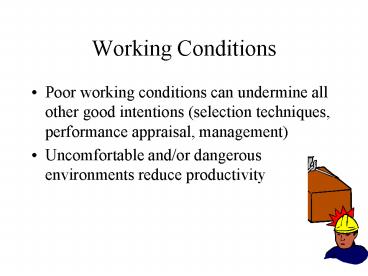Working Conditions - PowerPoint PPT Presentation
1 / 16
Title:
Working Conditions
Description:
Uncomfortable and/or dangerous environments reduce productivity ... Darker paints, non-glossy paints and monitors. Natural Light do people need it? Noise ... – PowerPoint PPT presentation
Number of Views:3169
Avg rating:3.0/5.0
Title: Working Conditions
1
Working Conditions
- Poor working conditions can undermine all other
good intentions (selection techniques,
performance appraisal, management) - Uncomfortable and/or dangerous environments
reduce productivity
2
Physical Working Conditions
- Work Sites
- Location high traffic area, city/suburb.
Younger workers seem to prefer cities - Ease of navigation maze-like? Delivery people
- Child and Dependent-Care Facilities 2/3 of all
new employees are women of childbearing age - Reduces absenteeism rates
- Increases organizational commitment
- Growing need for elder care
3
Office Design
- Issues such as heating, AC, bathrooms, elevators
- Especially crucial for individuals with
disabilities - Proximity of managers offices influences
spontaneous interactions - Building size can influence formality of
relations and morale - Class Design further student sits from the
teacher the worse their grade
4
Environmental Psychology
- Scientifically studies the effect of workplace
design on behavior - Landscaped offices were originally designed by
this field - Contain no walls, cubicles. Supposed to
facilitate communication between workers - Linked to job dissatisfaction. Complaints
include lack of privacy, noise, and
deindividuation
5
Illumination
- Intensity
- Optimal level varies with the nature of the task
and the age of the worker - Distribution
- Indirect lighting provides uniform illumination.
Reduces eye strain - Glare
- Reduces visual efficiency, increases eyestrain
- Darker paints, non-glossy paints and monitors
- Natural Light do people need it?
6
Noise
- Overall noise levels have increased 11 in the
1990s - Brief noise can cause permanent hearing loss
- Continuous noise is associated with high blood
pressure and muscle tension. - Even though we psychologically adjust, physiology
remains elevated - Loss of information in noisy environments?
7
Color
- Exaggerated claims have been made about room
color. Some truth exists however - Color coding useful for safety and navigation
- Used to reduce glare and eyestrain
- Influences temperature perception
8
Music
- Age old tradition in factories. History of music
and readings - Today it is most commonly provided by Muzak
- Muzak actually takes circadian rhythms into
account and adjusts style of music to time of day
9
Temperature and Humidity
- Higher temperatures lead to a greater need for
rest. More so for extreme physical exertion - Automated office equipment produces heat and
reduces humidity which may make the work
environment uncomfortable
10
Temporal Conditions
- Traditional Work Week 6days/10 hrs a day
- 1938 Fair Labor Standards Act instituted the 5
day, 40 hour week - Nominal working hours prescribe of hours one
is supposed to work. Not the actual amount of
time spent working - As you increase nominal you decrease actual
- Working overtime decreases overall productivity
11
Permanent Part-Time Employment
- On the increase. Why?
- Companies save . Do not have to provide full
benefits to part-time workers. - Companies receive increased production (nominal
time vs. actual) - Workers (some) prefer the increased flexibility,
particularly single mothers
12
Other Time Options
- 4 Day Work Week leads to reduced absenteeism,
easier to schedule workers - Some companies allow every other Friday off
- Flextime combines core mandatory work periods
with elective periods at the beginning and end of
the day - Work between 6.5-9.5 hours
- Helps with traffic congestion
- Many workers barely change (8 min. later, 22 min.
longer), but report feeling better
13
Shift Work
- Work periods for 24 hr. a day operations
- Usually 7am-3pm, 3-11, 11-7am
- 25 of Americans do shift work
- Impact on workers?
- Less productive on the night shift
- More serious accidents on the night shift
- More mistakes are made on the night shift
- Caused by interruption of Circadian Rhythms
- Reduce problems by reducing frequency of shift
changes or assigning permanent shifts
14
Psychological and Social Working Conditions
- Job simplification the reduction of
manufacturing jobs to the simplest components
that can be mastered - Horrible physical and psychological effects on
workers - Originally made sense for mass production
industries - Stimulated the American economy
15
Fatigue
- A psychological and physiological concept
- Ebbs and flows during the day
- Seems linked to motivation
- Factors linked to fatigue include
- Low job challenge
- Poor supervision
- Low job control
- Low ratings by supervisor
- Low pay
- Low information processing demands
16
Telecommuting
- Increasing due to advances in PCs and fax
technology - Approximately 15 million Americans
- Companies report gains in productivity and
reduction in office overhead and absenteeism - Pitfalls include lack of social interaction,
reality that some workers need supervision































